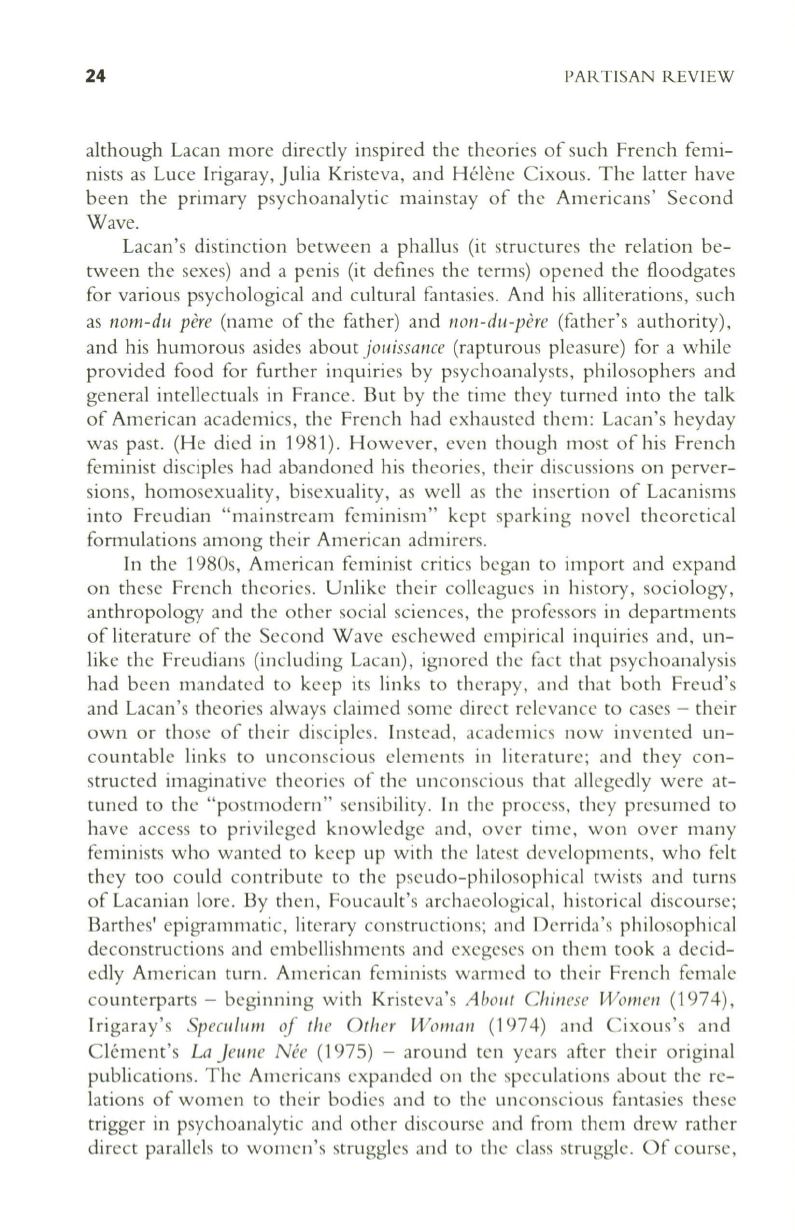
24
PARTISAN REVIEW
although Lacan more directly inspired the theories of such French femi–
nists as Luce lrigaray, Julia Kristeva, and Helene Cixous. The latter have
been the primary psychoanalytic mainstay of the Americans' Second
Wave.
Lacan's distinction between a phallus (it structures the relation be–
tween the sexes) and a penis (it defines the terms) opened the floodgates
for various psychological and cultural fantasies. And his alliterations, such
as
nom-du pere
(name of the father) and
non-du-pere
(father's authority),
and his humorous asides about
jouissance
(rapturous pleasure) for a while
provided food for further inquiries by psychoanalysts, philosophers and
general intellectuals in France. But by the time they turned into the talk
of American academics, the French had exhausted them: Lacan's heyday
was past. (He died in 1981) . However, even though most of his French
feminist disciples had abandoned his theories, their discussions on perver–
sions, homosexuality, bisexuality, as well as the insertion of Lacanisms
into Freudian "mainstream feminism" kept sparking novel theoretical
formulations among their American admirers.
In the 1980s, American feminist critics began to import and expand
on these French theories. Unlike their colleagues in history, sociology,
anthropology and the other social sciences, the professors in departments
of literature of the Second Wave eschewed empirical inquiries and, un–
like the Freudians (including Lacan), ignored the fact that psychoanalysis
had been mandated to keep its links to therapy, and that both Freud's
and Lacan's theories always claimed some direct relevance to cases - their
own or those of their disciples. Instead , academics now invented un–
countable links to unconscious elements in literature; and they con–
structed imaginative theories of the unconscious that allegedly were at–
tuned to the "postmodern" sensibility.
In
the process, they presumed
to
have access to privileged knowledge and, over time , won over many
feminists who wanted to keep up with the latest developments, who felt
they too could contribute to the pseudo-philosophical twists and turns
of Lacanian lore . By then, Foucault's archaeological, historical discourse;
Barthes' epigrammatic, literary constructions; and Derrida 's philosophical
deconstructions and embellishments and exegeses on them took a decid–
edly American turn . American feminists warmed to their French female
counterparts - beginning with Kristeva's
Abollt Chinese Women (1974),
lrigaray's
Spewlum of the Other WO/'/'lal1
(1974) and Cixous's and
Clement's
La Jeune Nee
(1975) - around ten years after their original
publications. The Americans expanded on the speculations about the re–
lations of women to their bodies and to the unconscious fantasies these
trigger in psychoanalytic and other discourse and from them drew rather
direct parallels to women's struggles and to the class struggle. Of course,


